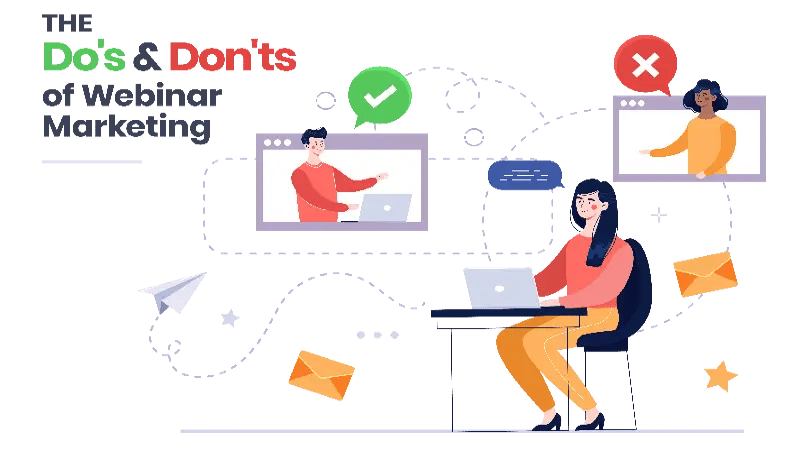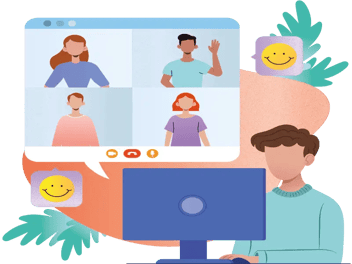I do's e i don't del marketing dei webinar
I webinar consentono alle aziende di entrare in contatto con il pubblico di tutto il mondo, fornendo al contempo contenuti di valore e di grande impatto. Tuttavia, come ogni strumento di marketing, per avere successo è necessario tenere a mente alcuni "do's" e "don'ts".
Dalla scelta di un argomento di spicco alla promozione dell'evento come un vero e proprio boss, vi illustreremo tutti i "do's" del webinar marketing. E, proprio come ogni esperto di marketing, condivideremo anche i "non", tra cui come evitare di essere troppo venditivi o di annoiare il pubblico fino alle lacrime.


I webinar sono un modo efficace per entrare in contatto con il vostro pubblico di riferimento, costruire il vostro marchio e generare contatti. Ma come si fa a creare un webinar che si distingua e attragga un vasto pubblico?
Cominciamo con le cose da fare per creare e promuovere il vostro webinar.
I "Do" del marketing dei webinar
1. Fornite contenuti di valore che soddisfino le esigenze del vostro pubblico di riferimento.
I contenuti del webinar devono essere validi e rilevanti per il vostro pubblico di riferimento. Assicuratevi che il vostro webinar affronti i loro punti dolenti e risolva i loro problemi. Offrite suggerimenti, trucchi e best practice che il pubblico possa utilizzare per migliorare la propria attività o la propria vita privata. Se il pubblico ritiene di aver appreso qualcosa di prezioso dal webinar, è più probabile che partecipi agli eventi futuri e li condivida con la propria rete.
Suggerimento: fate ricerche.
Prima di iniziare a pianificare il webinar, dedicate un po' di tempo alla ricerca del vostro pubblico di riferimento. Quali sono i loro punti dolenti? Quali sono i loro obiettivi? Cosa sono interessati a conoscere? Una volta che avrete compreso bene il vostro pubblico, potrete iniziare a sviluppare contenuti che siano rilevanti e di valore per loro.
Esempio: Supponiamo che siate un consulente aziendale che aiuta le piccole imprese a crescere. Il vostro pubblico di riferimento sono i proprietari di piccole imprese che vogliono migliorare la loro attività. Potreste creare un webinar su come creare un piano di marketing di successo. Nel vostro webinar, dovreste trattare argomenti quali:
-
-
-
Come identificare il mercato di riferimento
-
Come creare un budget di marketing
-
Come scegliere i canali di marketing giusti
-
Come misurare il successo delle campagne di marketing
-
-
Questo webinar sarà prezioso per il vostro pubblico di riferimento perché fornirà loro le informazioni necessarie per migliorare i loro sforzi di marketing.
2. Scegliete un argomento pertinente e che attiri l'attenzione per il vostro webinar.
L'argomento del webinar deve essere sia pertinente che in grado di attirare l'attenzione. Deve essere in linea con gli obiettivi aziendali e interessare il pubblico di riferimento. Scegliete un argomento che risolva un problema, affronti un punto dolente comune o fornisca informazioni preziose. Anche un titolo accattivante può contribuire ad attirare i potenziali partecipanti.
Suggerimento: pensate al vostro pubblico di riferimento.
Quando scegliete un argomento per il vostro webinar, considerate il vostro pubblico di riferimento. A cosa sono interessati? Quali sono i loro punti dolenti? Quali sono i loro obiettivi? Una volta che avete una buona comprensione del vostro pubblico, potete iniziare a pensare ad argomenti che siano rilevanti e interessanti per loro.
Esempio: Supponiamo che siate un consulente di marketing che aiuta le piccole imprese a crescere. Il vostro pubblico di riferimento sono i proprietari di piccole imprese che vogliono migliorare la loro attività.
Potreste creare un webinar su come creare un piano di marketing di successo. Questo argomento sarebbe rilevante per il vostro pubblico perché li aiuterebbe a migliorare la loro attività.
Inoltre, il titolo del webinar potrebbe essere qualcosa come "Come creare un piano di marketing di successo in 5 passi". Questo titolo è accattivante e attira l'attenzione, e probabilmente susciterà l'interesse dei potenziali partecipanti.
3. Promuovete il webinar attraverso diversi canali, come i social media, l'email marketing e il vostro sito web.
La promozione del webinar è fondamentale per attirare un vasto pubblico. Utilizzate diversi canali per promuovere il vostro evento, tra cui i social media, l'email marketing e il vostro sito web. Sfruttate il vostro pubblico esistente condividendo l'evento sulle vostre pagine di social media e inviando e-mail alla vostra lista. Utilizzate la pubblicità a pagamento per raggiungere un pubblico più vasto.
Come fare: creare una pagina di registrazione.
Il primo passo per promuovere il webinar è creare una pagina di registrazione. Questa pagina deve contenere tutte le informazioni importanti sul webinar, come l'argomento, la data, l'ora e il relatore. Dovrebbe anche includere un link per registrarsi al webinar.
Esempio: Supponiamo che siate un consulente di marketing che aiuta le piccole imprese a crescere. Potreste creare una pagina di registrazione per un webinar sulla creazione di un piano di marketing di successo. La pagina dovrebbe contenere le seguenti informazioni:
-
-
- Titolo: Come creare un piano di marketing di successo in 5 fasi
- Data: mmm gg, aaaa
- Orario: 10:00 - 11:00 EST
- Relatore: John Smith, consulente di marketing
- Descrizione: In questo webinar imparerete a creare un piano di marketing di successo che vi aiuti a far crescere la vostra attività. Imparerete a identificare il vostro mercato di riferimento, a creare un budget di marketing, a scegliere i canali di marketing giusti e a misurare il successo delle vostre campagne di marketing.
- Registrazione: Fare clic qui per registrarsi al webinar.
-

4. Utilizzate una piattaforma webinar affidabile e facile da usare.
Una piattaforma webinar affidabile e facile da usare è essenziale per il successo del vostro evento. Scegliete una piattaforma facile da usare sia per voi che per i partecipanti. Assicuratevi che la piattaforma sia adatta alle dimensioni del vostro pubblico e che offra funzioni come sondaggi in diretta, domande e risposte e condivisione dello schermo.
5. Preparate e provate la vostra presentazione per garantire un'esecuzione senza intoppi.
La preparazione è fondamentale per il successo di un webinar. Assicuratevi di avere una presentazione ben strutturata e di provarla in anticipo. Questo garantirà una presentazione fluida e vi aiuterà a sentirvi sicuri durante l'evento.
6. Coinvolgete il pubblico attraverso sessioni di domande e risposte e sondaggi.
Coinvolgere il pubblico durante il webinar è essenziale per mantenerlo interessato e attento. Utilizzate funzioni come le sessioni di domande e risposte e i sondaggi dal vivo per incoraggiare l'interazione e il feedback. Questo può aiutarvi a valutare gli interessi e le esigenze del pubblico e ad apportare modifiche durante la presentazione.
7. Seguite i partecipanti dopo il webinar con un'e-mail di ringraziamento e con risorse aggiuntive.
Il follow-up del webinar è essenziale per costruire un rapporto con i partecipanti. Inviate un'e-mail di ringraziamento che riassuma l'evento, i punti chiave e le risorse aggiuntive. Questo vi aiuterà a continuare a fornire valore al vostro pubblico e a mantenerlo impegnato con il vostro marchio.
Suggerimento: inviate un'e-mail di ringraziamento entro 24 ore dal webinar.
L'e-mail di ringraziamento deve ringraziare i partecipanti per aver partecipato al webinar e riassumere i risultati principali. Potete anche includere un link alla registrazione del webinar o una copia del materiale di presentazione.
Esempio: Supponiamo che abbiate tenuto un webinar su come creare un piano di marketing di successo. Potreste inviare un'e-mail di ringraziamento ai partecipanti entro 24 ore dal webinar. L'e-mail potrebbe includere quanto segue:
-
-
-
Oggetto: Grazie per aver partecipato al nostro webinar sulla creazione di un piano di marketing di successo!
-
Corpo: Caro [nome del partecipante],
-
-
Grazie per aver partecipato al nostro webinar sulla creazione di un piano di marketing di successo! Ci auguriamo che le informazioni siano state utili.
Ecco alcuni punti chiave del webinar:
-
-
-
- Identificare il mercato di riferimento. Prima di creare un piano di marketing di successo, è necessario identificare il mercato di riferimento. Chi state cercando di raggiungere? Quali sono le loro esigenze e i loro desideri?
- Creare un budget di marketing. Una volta conosciuto il mercato di riferimento, è necessario creare un budget di marketing. Quanto denaro siete disposti a spendere per il marketing?
- Scegliete i canali di marketing giusti. Sono disponibili molti canali di marketing diversi, come i social media, l'e-mail marketing e la pubblicità a pagamento. Dovete scegliere i canali giusti per il vostro mercato target e per il vostro budget.
- Misurare il successo delle campagne di marketing. Una volta lanciate le campagne di marketing, è necessario misurarne il successo. Quante persone state raggiungendo? State generando contatti? State realizzando vendite?
-
-
Ci auguriamo che queste informazioni vi siano state utili. Se avete domande, non esitate a contattarci.
Cordiali saluti, [Nome]
-
-
-
Invito all'azione: includete un invito all'azione nella vostra e-mail di ringraziamento. Ad esempio, potreste invitare i partecipanti a iscriversi alla vostra newsletter o a scaricare un ebook gratuito.
-
-
Seguendo queste best practice, è possibile creare webinar coinvolgenti ed efficaci, in grado di generare lead e vendite per la vostra azienda.
Le cose da non fare nel marketing dei webinar
Se sapere cosa fare è essenziale, sapere cosa non fare è altrettanto fondamentale nel webinar marketing. In questa sezione esamineremo alcuni errori comuni da evitare, in modo da garantire che il vostro webinar si distingua per tutte le ragioni giuste.
1. Non siate troppo venditori.
Uno degli errori più gravi commessi da chi si occupa di webinar è quello di essere troppo venditori. Se il pubblico si sente venduto, si disaffeziona rapidamente. Concentratevi invece sull'offerta di contenuti di valore che rispondano alle loro esigenze e ai loro punti dolenti. Anche se promuovere i vostri prodotti o servizi va bene, assicuratevi di farlo in modo sottile e non invasivo.
I webinar possono essere uno strumento eccellente per coinvolgere il pubblico, ma solo se la presentazione è coinvolgente. Evitate una presentazione noiosa o monotona e aggiungete invece un po' di entusiasmo ed energia alla vostra presentazione. Incorporate supporti visivi, come diapositive o video, per tenere il pubblico impegnato.
La scelta di un argomento troppo ampio o troppo di nicchia può portare a una scarsa partecipazione e a un basso coinvolgimento. Un argomento troppo ampio potrebbe non essere abbastanza specifico da attirare un pubblico mirato, mentre un argomento troppo di nicchia potrebbe non interessare un pubblico abbastanza ampio. È possibile trovare un equilibrio e scegliere un argomento abbastanza specifico da attirare il pubblico target, ma abbastanza ampio da interessare un pubblico più ampio.
I problemi tecnici possono essere una distrazione significativa durante un webinar. Testate la tecnologia e la connessione a Internet in anticipo per evitare qualsiasi inconveniente. Assicuratevi che il microfono e la telecamera funzionino e che la connessione a Internet sia stabile.
Il coinvolgimento del pubblico è fondamentale per mantenerlo interessato e attento durante il webinar. Utilizzate funzioni come sessioni di domande e risposte e sondaggi dal vivo per incoraggiare l'interazione e il feedback. Rispondete alle loro domande e preoccupazioni e fateli sentire ascoltati e apprezzati.
Il follow-up con i partecipanti dopo il webinar è fondamentale per costruire un rapporto con loro. Inviate un'e-mail di ringraziamento che riassuma l'evento, i punti chiave e le risorse aggiuntive. Questo vi aiuterà a continuare a fornire valore al vostro pubblico e a mantenerlo impegnato con il vostro marchio.
Evitando questi errori comuni, potrete creare webinar coinvolgenti ed efficaci, in grado di generare contatti e vendite per la vostra azienda.
Marketing dei webinar: È tutta una questione di equilibrio
Un webinar marketing efficace consiste nel trovare un equilibrio tra le cose da fare e quelle da non fare. Seguendo le best practice descritte in questo blog post, potete creare webinar coinvolgenti e informativi che attirino e fidelizzino un pubblico mirato. Ricordate di concentrarvi sull'offerta di valore al pubblico, piuttosto che sulla promozione dei vostri prodotti o servizi.
Tuttavia, anche se seguite tutti i passi giusti, il successo non è garantito. Come in tutte le cose della vita, c'è sempre un elemento di imprevedibilità. A volte, le cose più inaspettate possono portare alle vittorie più significative. Quindi, se da un lato è fondamentale avere un piano e rispettarlo, dall'altro non abbiate paura di rischiare e di provare cose nuove.
Un webinar marketing efficace consiste nel trovare il giusto equilibrio tra il rispetto delle best practice e l'assunzione di rischi creativi. In questo modo è possibile creare webinar che attraggano e coinvolgano il pubblico e che portino lead e vendite alla vostra azienda. Perciò, fate il salto nell'eccitante mondo del webinar marketing e ricordate di tenere a mente la strategia, divertendovi ed essendo creativi.
Questo contenuto è disponibile in:
- Tedesco: Die Do's und Don'ts des Webinar-Marketings
- Inglese: The Do's and Don'ts of Webinar Marketing
- Spagnolo: Qué hacer y qué no hacer en el marketing de seminarios web
- Francese: Les choses à faire et à ne pas faire dans le cadre d'un webinaire
- Rumeno: Ce trebuie și ce nu trebuie să faceți în marketingul webinarelor
- Cinese: 网络研讨会营销的注意事项







.webp?width=352&name=Blog_WBM_Creating%20a%20Killer%20Webinar%20Presentation%20Tips%20and%20Best%20Practices%20(1).webp)
Facci sapere cosa ne pensi.